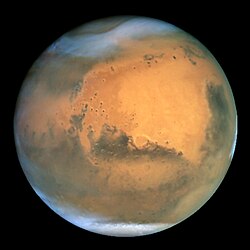High Resolution Stereo Camera
High Resolution Stereo Camera (HRSC) je stereoskopická fotografická kamera kombinovaná s kamerou s vysokým rozlišením v projektu Mars Express.[1] Vznikla z původní verze určené pro Zemi s názvem HRSC-AX a byla vylepšena jako verze pro Mars 96.[1] Jejím obsahem je 5 hlavních částí: hlava kamery, super resolution channel, rám na zařízení a digitální jednotku.[1] Z výšky 250 km nad povrchem Marsu může pořizovat snímky terénu s rozlišením 2,3 metrů/pixel na čtverci o straně 2,35 km.[1] Obsahuje ještě dalších 9 kanálů a může produkovat digitální modely terénu.[1]
Odkazy
Reference
Externí odkazy
 Obrázky, zvuky či videa k tématu High Resolution Stereo Camera na Wikimedia Commons
Obrázky, zvuky či videa k tématu High Resolution Stereo Camera na Wikimedia Commons - ESA - High Resolution Stereo Camera
- Aeolis Mons (Mt. Sharp) and Gale - Image/HRSCview Archivováno 7. 8. 2017 na Wayback Machine
- Aeolis Mons (Mt. Sharp) - HRSCview Archivováno 5. 8. 2016 na Wayback Machine (oblique view looking east)
Média použitá na této stránce
Curiosity Cradled by Gale Crater
NASA's Curiosity rover landed in the Martian crater known as Gale Crater, which is approximately the size of Connecticut and Rhode Island combined. A green dot shows where the rover landed, well within its targeted landing ellipse, outlined in blue.
This oblique view of Gale, and Mount Sharp in the center, is derived from a combination of elevation and imaging data from three Mars orbiters. The view is looking toward the southeast. Mount Sharp rises about 3.4 miles (5.5 kilometers) above the floor of Gale Crater.
The image combines elevation data from the High Resolution Stereo Camera on the European Space Agency's Mars Express orbiter, image data from the Context Camera on NASA's Mars Reconnaissance Orbiter, and color information from Viking Orbiter imagery. There is no vertical exaggeration in the image.NASA's Hubble Space Telescope took the picture of Mars on June 26, 2001, when Mars was approximately 68 million kilometers (43 million miles) from Earth — the closest Mars has ever been to Earth since 1988. Hubble can see details as small as 16 kilometers (10 miles) across. The colors have been carefully balanced to give a realistic view of Mars' hues as they might appear through a telescope. Especially striking is the large amount of seasonal dust storm activity seen in this image. One large storm system is churning high above the northern polar cap (top of image), and a smaller dust storm cloud can be seen nearby. Another large dust storm is spilling out of the giant Hellas impact basin in the Southern Hemisphere (lower right).


